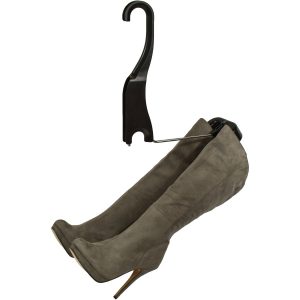
We love boots of all kinds at Boot Butler, and if you’re reading this — chances are you do too. Today we thought we’d explore the world of riding boots. Whether you’re a novice rider, just thinking about taking some lessons, or an expert, a proper riding boot will make the time you spend on a gorgeous horse all the more enjoyable, and safe.
This next part perhaps goes without saying, but fashion riding boots and riding boots are not the same. Fashion riding boots are designed to look similar to actual riding boots, but their construction varies vastly: Fashion boots are not built to withstand the movements that you perform while mounting, riding, and dismounting a horse. And they don’t have the crucial support across the top of the toe that’s so important when you’re around a very heavy animal. Plus, you don’t ever want to get your foot caught in a stirrup while riding, so the right footwear is very important. Let’s check out some common riding boot types. Generally, riding boots can be divided by the riding style, so different boots will match the English or Western style you’re going to be riding.
ENGLISH TALL BOOTS
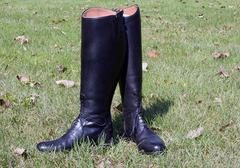 If you’re a Downton Abbey fan, you’ve no doubt watched some great riding scenes, where nattily dressed Brits stream across beautiful fields on their equally beautiful horses. They’re probably wearing English Tall Boots. Various types of these boots exist but are always tall (hence, the name). They can either be zipped up or pulled up, and they cover the lower part of the leg up to the knee. Note that the zip-up versus pull-up option is a matter of personal preference, though the zip-up option will generally be a bit more expensive, and also a bit easier to take on and off.
If you’re a Downton Abbey fan, you’ve no doubt watched some great riding scenes, where nattily dressed Brits stream across beautiful fields on their equally beautiful horses. They’re probably wearing English Tall Boots. Various types of these boots exist but are always tall (hence, the name). They can either be zipped up or pulled up, and they cover the lower part of the leg up to the knee. Note that the zip-up versus pull-up option is a matter of personal preference, though the zip-up option will generally be a bit more expensive, and also a bit easier to take on and off.
Tall boots with laces are called field boots. (They’re called that because they were worn by officers with a “field grade” or higher.) These feature laces around the ankle part, meaning that the lower portion of the boot will have a bit more give. That’s especially helpful for jumping when you want a little more flexibility, and also when you need to shorten your stirrups to prepare for a jumping position.
Tall boots without laces are called dress boots. This type of boot is commonly seen at riding competitions. Dress boots are less flexible, have a more rigid shaft, and are more ornamental in their styling. That has a dual purpose: Both for a little flair while performing in shows, but also to help keep the leg in place. A dress boot with a cuff at the top is called a hunting boot. That cuff will typically be a shade of brown.
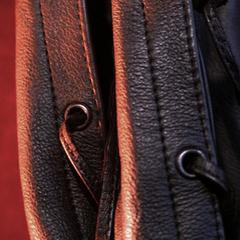
Now, let’s talk materials. Riding boots are and have been traditionally made of leather. The leather is sturdy, can be waterproofed, and when cared for correctly, can last for years. And because there’s a certain amount of pliability within leather, in time, it’ll mold to your legs. Your boots will give where they need to give, but also protect you in all the right spots.
But there’s another option: Rubber riding boots. They’re simple to maintain, easy to clean with water, and are less affected by the elements. If you’re just starting out, or on a budget, or you want a secondary pair of boots, then a rubber riding boot may work well for you. You’ll probably want to avoid wearing them while riding in the heat, as the rubber won’t breathe, and you can rack up some uncomfortable blisters. And while they’re easy to care for, rubber boots scuff easier and will dull over time. Whereas you can keep leather moisturized and shiny with leather oil and cream, you’re limited with what you can do to a rubber boot to make it stay looking well-cared for.
PADDOCK BOOTS
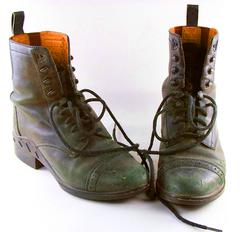 Paddock, or short boots, are meant to be used for everyday riding (not in shows). You can wear them alone or with a pair of half chaps that will protect the lower part of your leg. They’re perfect for classes and are usually comfy enough to wear all day long.
Paddock, or short boots, are meant to be used for everyday riding (not in shows). You can wear them alone or with a pair of half chaps that will protect the lower part of your leg. They’re perfect for classes and are usually comfy enough to wear all day long.
Paddock boots will cover your ankles, which is important for support. The soles will often be made out of rubber or similar material. That makes them good for all sorts of weather, and they’re also a good choice for barn work, as stepping into various puddles won’t damage them when you’re mucking out.
Paddock boots are also a good choice for younger riders, as they’ll generally be less expensive than tall boots.
WESTERN BOOTS
If you’ve ever seen a rodeo, you’ve seen plenty of Western-style riding boots in action. The cowboys and cowgirls will be sporting two-inch heels that are angled — that angle is to keep their feet from sliding through their stirrups. For that same stirrup safety reason, these boots feature smooth leather soles that won’t catch in the stirrups should the rider take a fall. The 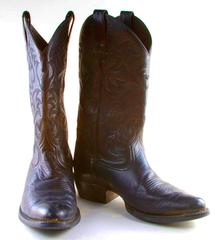 toe is tapered so that you can pop them into stirrups more easily, and the shaft goes to at least the mid-calf so that legs are protected from getting pinched in the saddle. There’re traditionally no laces on a Western riding boot, as these can get caught or tangled in the stirrups.
toe is tapered so that you can pop them into stirrups more easily, and the shaft goes to at least the mid-calf so that legs are protected from getting pinched in the saddle. There’re traditionally no laces on a Western riding boot, as these can get caught or tangled in the stirrups.
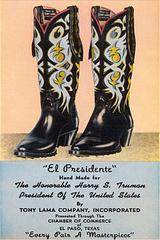 At a calf roping event, the riders will be wearing ropers. These feature a low heel (what’s called a walking heel, which is just a little over an inch); a rounded toe; flexible sole; and lacing. The lacing is great for ankle support and a good fit, but shouldn’t be used for traditional riding because of the stirrup issue.
At a calf roping event, the riders will be wearing ropers. These feature a low heel (what’s called a walking heel, which is just a little over an inch); a rounded toe; flexible sole; and lacing. The lacing is great for ankle support and a good fit, but shouldn’t be used for traditional riding because of the stirrup issue.
Cowboy boots (which are the most typical types of Western boots) can be worn for very low-key riding, but mostly as an everyday boot. Their angled heels are 1.5 inches or more, and the shaft will go to your mid-calf. More on cowboy boots in this blog post.There’s also a work Western boot. This boot will have a lower, non-angled heel, and meant to be used for activities when you’re on your feet, as well as on a horse. The soles will often be made of rubber and have treading for traction. This type of boot is more practical and functional and will be much less ornamental than any other Western boot.
MUCK BOOTS
Lastly, let’s talk muck boots. Because you definitely don’t want to be mucking out in your riding boots, whether English or Western style.
Muck boots are tall or mid-calf rubber boots and they’re great for when you’re doing chores in the barn. They come either lined or unlined, so depending on the weather, choose appropriately. The lined versions will be a good choice if you’re in cool or cold weather.
CLEANING and STORAGE
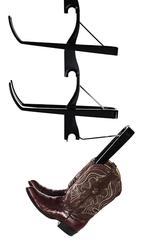
For tips on cleaning and maintaining your boots, check out this blog post.
And of course, we have to give ourselves a little plug here: Riding boots are an investment. And when you’ve got them nice and clean after a wonderful day of riding, do them, and yourself a favor, and hang them up on our Boot Butler. It’ll keep them in the proper position, crease-free, until the next time you saddle up.

